Waterloo, Ontario
Waterloo is a city in Ontario, Canada. It is the smallest of three cities in the Regional Municipality of Waterloo (and previously in Waterloo County, Ontario), and is adjacent to the city of Kitchener.
Waterloo | |
|---|---|
City (lower-tier) | |
| City of Waterloo | |
Uptown Waterloo, looking south down King Street. | |
| Nickname(s): "The Tri-Town", "The 'Loo", "K–W" | |
| Motto(s): Stability | |
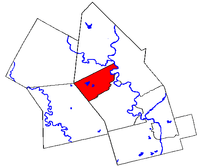 | |
 Waterloo Location of Waterloo in Ontario | |
| Coordinates: 43°28′N 80°31′W | |
| Country | |
| Province | |
| Region | Waterloo |
| Incorporated | May 27, 1857 |
| Government | |
| • Mayor | Dave Jaworsky |
| • Governing Body | Waterloo City Council |
| • City CAO | Tim Anderson |
| • MP | Bardish Chagger (Liberal) |
| • MPP | Catherine Fife (NDP) |
| Area | |
| • Land | 64.02 km2 (24.72 sq mi) |
| Elevation | 329 m (1,079 ft) |
| Population | |
| • City (lower-tier) | 104,986 (51st) |
| • Density | 1,520.7/km2 (3,939/sq mi) |
| • Metro | 523,894 (10th) |
| Demonym(s) | Waterluvian[3] |
| Time zone | UTC−5 (Eastern (EST)) |
| • Summer (DST) | UTC−4 (EDT) |
| Forward sortation area | N2J to N2L, N2T to N2V |
| Area code(s) | 519 and 226 |
| Website | www.waterloo.ca |
Kitchener and Waterloo are often jointly referred to as "Kitchener–Waterloo", "KW", or the "Twin Cities" (when the reference includes the nearby city of Cambridge, Ontario, the term "Tri-Cities" or "the Tri-City" are used). While there were several unsuccessful attempts to combine the municipalities of Kitchener and Waterloo, following the 1973 establishment of the Region of Waterloo there was less motivation to do so. At the time of the 2016 census, the population of Waterloo was 104,986.[1]
History
The Haldimand Proclamation was a land grant to the Iroquois to compensate for their wartime alliance with the British during the American Revolution.[4] Block Number 2 (aka Block 2) was purchased by Richard Beasley from Joseph Brant (on behalf of the Six Nations in 1796) with a mortgage held by the Six Nations. Block 2, 94,012 acres in size, was situated in the District of Gore. To meet his mortgage obligations Beasley had to sell portions of the land to settlers.[5] This was counter to the original mortgage agreement, but subsequent changes to the agreement were made to permit land sales.
Mennonites from Pennsylvania counties Lancaster and Montgomery were the first wave of immigrants to the area.[6] In the year 1800 alone Beasley sold over 14,000 acres to Mennonite settlers.
A group of 26 Mennonites from Lancaster County, Pennsylvania pooled their resources into the German Company of Pennsylvania which was then represented by Daniel Erb and Samuel Bricker.[7] The Company purchased all the unsold land from Beasley in 1803 resulting in a discharge of the mortgage held by the Six Nations. This discharge allowed Beasley to clear his obligation with the Six Nations, and allowed the settlers to have deeds to their purchased land.[8] The payment to Beasley, in cash, arrived from Pennsylvania in kegs, carried in a wagon surrounded by armed guards.[9]
Many of the pioneers that arrived from Pennsylvania after November 1803 bought land in a 60,000 acre tract of Block 2 from the German Company of Pennsylvania. The tract included almost two-thirds of Block 2. Many of the first farms were least four hundred acres in size.[10]
The Mennonites divided the land into smaller lots; two lots owned by Abraham Erb became the central core of Waterloo. Erb, often called the founder of Waterloo, had come to the area in 1806 from Franklin County, Pennsylvania. He bought 900 acres of bush land in 1806 from the German Company and founded a sawmill (1808) and grist mill (1816); these the focal point of the area. The grist mill operated continuously for 111 years. Other early settlers of what would become Waterloo included Samuel and Elia Schneider who arrived in 1816. Until about 1820, settlements such as this were quite small.[10][11]
In 1816 the new Waterloo Township was officially incorporated while being named after Waterloo, Belgium, the site of the Battle of Waterloo (1815), which had ended the Napoleonic Wars in Europe.[12] After that war, the new township became a popular destination for German immigrants. By the 1840s, German settlers had overtaken the Mennonites as the dominant segment of the population. Many Germans settled in the small hamlet to the southeast of Waterloo. In their honour, the village was named Berlin in 1833 (renamed to Kitchener in 1916).
By 1831, Waterloo had a small post office in the King and Erb Street area, operated by Daniel Snyder, some 11 years before one would open in neighbouring Berlin.[13] The Smith's Canadian Gazetteer of 1846 states that the Township of Waterloo (smaller than Waterloo County) consisted primarily of Pennsylvanian Mennonites and immigrants directly from Germany who had brought money with them. At the time, many did not speak English. There were eight grist and twenty saw mills in the township. In 1841, the population count was 4424. In 1846 the village of Waterloo had a population of 200, "mostly Germans". There was a grist mill and a sawmill and some tradesmen.[14] By comparison, Berlin (Kitchener) had a population of about 400, also "mostly German", and more tradesmen than the village of Waterloo.[15]
Berlin was chosen as the site of the seat for the County of Waterloo in 1853. By 1869, the population was 2000.[16] Waterloo was incorporated as a village in 1857 and became the Town of Waterloo in 1876 and the City of Waterloo in 1948.
In 2016, a corduroy road was unearthed in the King St. area of the business district; a second section was discovered near the Conestoga mall. The road was probably built by Mennonites using technology acquired in Lancaster County Pennsylvania, between the late 1790s and 1816. The log road was buried in about 1840 and a new road built on top of it.[17][18]
Geography
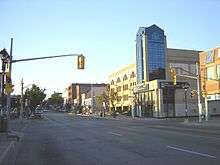
Waterloo's city centre is near the intersection of King and Erb streets. Since 1961, the centrepiece has been the Waterloo Town Square shopping centre, which underwent a thorough renovation in 2006. Much of the mall was torn down and has been replaced by buildings that emphasize street-facing storefronts.
Residents refer to the Waterloo city centre as "uptown" (often capitalized), while "downtown" is reserved for the Kitchener city centre, as Kitchener had been the dominant centre, and Waterloo was a small town on the Kitchener's north side. Waterloo surged into a significant City in the third-quarter of the 20th Century, due in large part to its role as a university city. It has also benefited with the growth of insurance companies. Waterloo has prospered with the relationship between the Tech Sector, which has blossomed, and the University of Waterloo whose technology graduates have excelled. Blackberry, formerly Research In Motion, is the best example.
The city centre was once along Albert Street, near the Marsland Centre and the Waterloo Public Library. The town hall, fire hall, and farmers' market were located there. Amidst some controversy, all were demolished between 1965 and 1969.
Parks
There are five main parks in the city:
- RIM Park occupies 200 hectares (490 acres) and is home to a variety of indoor and outdoor sporting facilities, including an eighteen-hole golf course, and the heritage Martin Farm House.
- Waterloo Park is in Uptown Waterloo, and contains historical buildings, a bandshell, and animal displays in its 45 hectares (110 acres).
- Bechtel Park occupies 44 hectares (110 acres) and has many outdoor sporting facilities along with wetlands, meadows and hardwood forest. The park also includes an off-leash dog park, and adjacent city-operated cemetery. Hillside Park covers 25 hectares (62 acres) and includes two lighted ball diamonds.
- Lexington Park includes a ball diamond and a soccer pitch on the former site of the K-W Municipal Airport.
- Laurel Creek Conservation Area, at 300 hectares (740 acres), lies in the northwest of the city.
Waterways
The Grand River flows southward along the city's east side. Its most significant tributary within the city is Laurel Creek, whose source lies just to the west of the city limits and its mouth just to the east, and crosses much of the city's central areas, including the University of Waterloo lands and Waterloo Park; it flows under the uptown area in a culvert. In the city's west end, the Waterloo Moraine provides over 300,000 people in the region with drinking water. Much of the gently hilly Waterloo Moraine underlies existing developed areas. Ongoing urban growth, mostly low-density residential suburbs (in accordance with requests by land developers), will cover increasing amounts of the remaining undeveloped portions of the Waterloo Moraine.
Climate
The Climate of Waterloo is Humid continental (Köppen) (Dfb)
| Climate data for Waterloo Regional Airport (1981−2010) | |||||||||||||
|---|---|---|---|---|---|---|---|---|---|---|---|---|---|
| Month | Jan | Feb | Mar | Apr | May | Jun | Jul | Aug | Sep | Oct | Nov | Dec | Year |
| Record high humidex | 13.4 | 13.0 | 28.0 | 33.7 | 39.6 | 43.2 | 47.7 | 48.3 | 41.2 | 34.5 | 24.4 | 22.1 | 48.3 |
| Record high °C (°F) | 14.2 (57.6) |
13.7 (56.7) |
27.0 (80.6) |
29.2 (84.6) |
32.0 (89.6) |
36.1 (97.0) |
36.0 (96.8) |
36.5 (97.7) |
33.3 (91.9) |
29.4 (84.9) |
21.7 (71.1) |
18.7 (65.7) |
36.5 (97.7) |
| Average high °C (°F) | −2.6 (27.3) |
−1.2 (29.8) |
3.6 (38.5) |
11.5 (52.7) |
18.5 (65.3) |
23.6 (74.5) |
26.0 (78.8) |
24.8 (76.6) |
20.4 (68.7) |
13.5 (56.3) |
6.3 (43.3) |
0.2 (32.4) |
12.0 (53.6) |
| Daily mean °C (°F) | −6.5 (20.3) |
−5.5 (22.1) |
−1 (30) |
6.2 (43.2) |
12.5 (54.5) |
17.6 (63.7) |
20.0 (68.0) |
18.9 (66.0) |
14.5 (58.1) |
8.2 (46.8) |
2.5 (36.5) |
−3.3 (26.1) |
7.0 (44.6) |
| Average low °C (°F) | −10.3 (13.5) |
−9.7 (14.5) |
−5.6 (21.9) |
0.8 (33.4) |
6.4 (43.5) |
11.5 (52.7) |
14.0 (57.2) |
12.9 (55.2) |
8.6 (47.5) |
2.9 (37.2) |
−1.4 (29.5) |
−6.8 (19.8) |
2.0 (35.6) |
| Record low °C (°F) | −31.9 (−25.4) |
−29.2 (−20.6) |
−25.4 (−13.7) |
−16.1 (3.0) |
−3.9 (25.0) |
−0.6 (30.9) |
5.0 (41.0) |
1.1 (34.0) |
−3.7 (25.3) |
−8.3 (17.1) |
−15.4 (4.3) |
−27.2 (−17.0) |
−31.9 (−25.4) |
| Record low wind chill | −40.5 | −37.1 | −30.2 | −20.6 | −8.1 | 0.0 | 0.0 | 0.0 | −4.1 | −11.9 | −22.2 | −31.2 | −40.5 |
| Average precipitation mm (inches) | 65.2 (2.57) |
54.9 (2.16) |
61.0 (2.40) |
74.5 (2.93) |
82.3 (3.24) |
82.4 (3.24) |
98.6 (3.88) |
83.9 (3.30) |
87.8 (3.46) |
67.4 (2.65) |
87.1 (3.43) |
71.2 (2.80) |
916.5 (36.08) |
| Average rainfall mm (inches) | 28.7 (1.13) |
29.7 (1.17) |
36.8 (1.45) |
68.0 (2.68) |
81.8 (3.22) |
82.4 (3.24) |
98.6 (3.88) |
83.9 (3.30) |
87.8 (3.46) |
66.1 (2.60) |
75.0 (2.95) |
38.0 (1.50) |
776.8 (30.58) |
| Average snowfall cm (inches) | 43.7 (17.2) |
30.3 (11.9) |
26.5 (10.4) |
7.3 (2.9) |
0.38 (0.15) |
0.0 (0.0) |
0.0 (0.0) |
0.0 (0.0) |
0.0 (0.0) |
1.4 (0.6) |
13.0 (5.1) |
37.2 (14.6) |
159.7 (62.9) |
| Average precipitation days (≥ 0.2 mm) | 18.2 | 14.2 | 13.8 | 13.7 | 12.4 | 12.0 | 10.6 | 10.7 | 12.2 | 13.9 | 16.4 | 18.1 | 166.0 |
| Average rainy days (≥ 0.2 mm) | 5.6 | 5.0 | 6.9 | 11.5 | 12.4 | 12.0 | 10.6 | 10.7 | 12.2 | 13.7 | 11.6 | 6.9 | 118.7 |
| Average snowy days (≥ 0.2 cm) | 16.1 | 11.9 | 9.0 | 3.3 | 0.18 | 0.0 | 0.0 | 0.0 | 0.0 | 0.91 | 6.5 | 14.4 | 62.2 |
| Average relative humidity (%) (at 6am) | 86.4 | 83.4 | 84.8 | 84.4 | 84.7 | 87.0 | 90.1 | 93.6 | 94.3 | 90.6 | 87.6 | 87.1 | 87.8 |
| Source: Environment Canada[19] | |||||||||||||
Waterloo has a humid continental climate of the warm summer subtype (Dfb under the Köppen climate classification); this means that there are large seasonal differences, usually very warm to hot (and humid) summers and cold (to very cold) winters. Compared to the rest of Canada, it has moderate weather. Winter temperatures generally last from the middle of December until the middle of March, while summer temperatures generally occur between the middle of May to close to the end of September. Temperatures can exceed 30℃ (86℉) several times a year. Waterloo has approximately 140 frost-free days per year.
Demographics
| Census | Population |
|---|---|
| 1841 | 200 |
| 1871 | 1,594 |
| 1881 | 2,066 |
| 1891 | 2,941 |
| 1901 | 3,537 |
| 1911 | 4,359 |
| 1921 | 5,883 |
| 1931 | 8,095 |
| 1941 | 8,968 |
| 1951 | 11,991 |
| 1961 | 21,366 |
| 1971 | 36,677 |
| 1981 | 49,428 |
| 1991 | 71,181 |
| 2001 | 86,543 |
| 2006 | 97,475 |
| 2011 | 98,780 |
| 2016 | 104,986 |
Many locals are of ethnic German descent. There is also a strong Mennonite presence. The universities and colleges along with its thriving technology and electronics presence attract a large number of individuals from elsewhere in Canada and the world.
The population according to the 2016 Canadian Census is 104,986[20] (Sources other than the census may indicate higher numbers due to treatment of the student population.)
According to the Canada 2011 Census,[21] the population of Waterloo was 98,780, a 1.3% increase from 2006. The population density was 1,542.9 people per square km. The median age was 37.6 years old, lower than the national median age at 40.6 years old. There are 42,984 private dwellings with an occupancy rate of 87.3%.
| Canada 2016 Census[22] | Population | % of Total | |
|---|---|---|---|
| Visible minority group | South Asian | 6,650 | 6.4% |
| Chinese | 9,565 | 9.3% | |
| Black | 1,990 | 1.9% | |
| Filipino | 545 | 0.5% | |
| Latin American | 1,405 | 1.4% | |
| Arab | 1,870 | 1.8% | |
| Southeast Asian | 1,185 | 1.1% | |
| West Asian | 1,150 | 1.1% | |
| Korean | 1,170 | 1.1% | |
| Japanese | 225 | 0.2% | |
| Visible Minority n.i.e | 610 | 0.6% | |
| Multiple Visible Minorities | 905 | 0.9% | |
| Total visible minority population | 27,265 | 26.4% | |
| Aboriginal group | First Nations | 1,595 | 1.5% |
| Métis | 655 | 0.6% | |
| Inuit | 25 | 0.0% | |
| Total Aboriginal population | 2,205 | 2.1% | |
| White | 73,920 | 71.5% | |
| Total - 25% sample data | 103,390 | 100% | |
The most common ethnic origins in Waterloo according to the 2016 Census are German (23.3%), English (23.1%), Canadian (21.2%), Scottish (18.3%), Irish (17.4%), Chinese (9.9%), French (8.4%), Dutch (5.0%), Polish (5.0%) and East Indian (4.7%).[23]
From the 2001 census data, excluding post-secondary students temporarily residing in Waterloo, residents are predominately Chrisitan, with 43.1% affiliated with Protestantism and 27.8% affiliated with Catholicism. No affiliation is the third largest group with 17.5% of the population. Other religion minorities include 2.8% Muslim, and 1.6% Hindu.[24]
Economy
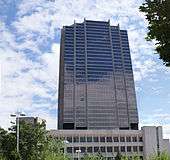
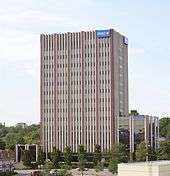
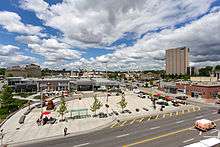
According to the 2016 Canadian Census, The City of Waterloo has a median household income (after tax) of $72239. This is significantly higher than the national median of $61348. The unemployment rate in Waterloo (6.9%) is lower than the national rate of 7.7%. The median value of a dwelling in Waterloo ($399997) is higher than the national median of $341556.[25]
Waterloo has a strong knowledge- and service-based economy with significant insurance and high-tech sectors as well as two universities.[26] The city's largest employers are Sun Life Financial, the University of Waterloo, Manulife Financial, BlackBerry, Sandvine and Wilfrid Laurier University.[27]
The city is also home to three well-known think tanks – the Perimeter Institute for Theoretical Physics, an advanced centre for the study of foundational, theoretical physics and award-winning educational outreach in science; the Institute for Quantum Computing, based at the University of Waterloo, which carries out innovative research in computer, engineering, mathematical and physical sciences; and the Centre for International Governance Innovation, an independent, nonpartisan think tank that addresses international governance challenges.
The city is part of Canada's Technology Triangle (CTT), a joint economic development initiative of Waterloo, Kitchener, Cambridge and the Region of Waterloo that markets the region internationally. Despite its name, CTT does not focus exclusively on promoting technology industries, but on all aspects of economic development.
Waterloo has a strong technology sector with hundreds of high-tech firms.[26] The dominant technology company in the city is BlackBerry, makers of the BlackBerry, which has its headquarters in the city and owns several office buildings near the University of Waterloo's main campus.
Notable Waterloo-based high-tech companies include:
- Aeryon Labs
- BlackBerry
- Dalsa
- Descartes Systems Group
- Kik Messenger
- Maplesoft
- MKS Inc.
- ON Semiconductor
- OpenText Corporation
- Sandvine
- Vidyard
Many other high-tech companies, with headquarters elsewhere, take advantage of the concentration of high-tech employees in the Waterloo area, and have research and development centres there. Shopify, SAP, Google, Oracle, Intel, McAfee, NCR Corporation, Electronic Arts and Agfa are among the large, international technology companies with development offices in Waterloo.
Before it became known for technology, Waterloo was sometimes[28] referred to as "the Hartford of Canada" because of the many insurance companies based in the area.[6] Manulife, Sun Life Financial, Equitable Life of Canada and Economical Insurance have a large presence in the city.
Breweries and distilleries had been a significant industry in the Waterloo area until 1993 when a Labatt-owned brewery was shut down. The Brick Brewing Company operated in Waterloo, but is now based in Kitchener. Waterloo was the original home of distiller Seagram (also home town of many descendants of J.P. Seagram), which closed its Waterloo plant in 1992. Of the remaining Seagram buildings, one became home of the Centre for International Governance Innovation (CIGI), while others were converted into condominiums.
The city encourages location filming of movies and TV series and many have taken advantage of Waterloo locations. Recent titles include Downsizing (released in 2017), The Demolisher (2015) and Degrassi: The Next Generation (2015).[29]
Largest employers in the city of Waterloo
The largest employers in the city of Waterloo are:[30]
Arts and culture
Events and festivals
- Winterloo (previously called the Ice Dogs Festival) – February
- GO! Music Festival – March
- Waterloo County & Area Quilt Festival – May
- Uptown Country Festival – June
- Canada Day Fireworks, Columbia Lake Fields – July 1
- Waterloo Jazz Festival – July
- Afro Festival- July
- Serbian Food Festival - July
- Waterloo Busker Carnival: Canada's premier busker carnival - August
- Serbian Days – St. George and Holy Trinity Orthodox Church of KW
- CAFKA: International Biennale of Contemporary Art – September
- KW Flying Dutchmen Scale Rally Model Airplane Show - September
- Royal Medieval Faire – September
- Expressions of Social Justice Festival – September
- Oktoberfest Parade – October
- Kitchener–Waterloo Oktoberfest: the largest Oktoberfest celebration outside of Germany – October
- Santa Claus Parade – November
- World Religions Conference : the largest multi-faith event of its kind in Canada featuring the world's major religions – October–November
- Waterloo Festival for Animated Cinema – November
- Wonders of Winter (festival of lights) – December
- Cinematheque Waterloo – Year round
- International Olympiad in Informatics(IOI)
- Tour De Waterloo - June
Attractions
Waterloo is home to several notable tourist attractions and areas of interest. These include:

- Canadian Clay and Glass Gallery
- Centre for International Governance Innovation
- Conestoga Mall
- Perimeter Institute for Theoretical Physics
- RIM Park
- Waterloo Memorial Recreation Complex
- Waterloo Central Railway
Other nearby attractions include:
- African Lion Safari (in Flamborough)
- Centre in the Square (in Kitchener)
- Doon Heritage Crossroads (in South Kitchener)
- St. Jacobs
- Joseph Schneider Haus (in Kitchener)
- Stratford Festival of Canada (in Stratford)
- THEMUSEUM, formerly the Waterloo Regional Children's Museum (in downtown Kitchener)
- Woodside National Historic Site (in Kitchener)
Sports
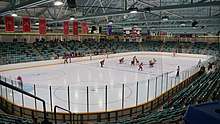
There are two lawn bowling clubs serving Waterloo: Heritage Greens LBC and Kitchener LBC, which both function as part of District 7 of the Ontario Lawn Bowling Association. Both clubs offer programs for all ages.
There are three sports teams and two university varsity teams.
- Waterloo Wildfire: play at National Ringette League from inaugural season.
- Waterloo Siskins: play at Greater Ontario Junior Hockey League
- SC Waterloo Region: play at Canadian Soccer League
Both play at Ontario University Athletics of Canadian Interuniversity Sport.
- Wilfrid Laurier Golden Hawks
- Waterloo Warriors
Government
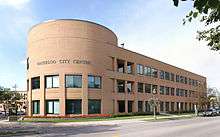
Waterloo City Council consists of seven councillors, each representing a ward, and a mayor. The number of wards expanded from five to seven in the November 2006 elections. The current mayor of Waterloo is Dave Jaworsky, who was elected in October 2014.[36] The current Waterloo City Council is constituted as follows:
- Ward 1 (Southwest): Sandra Hanmer
- Ward 2 (Northwest): Royce Bodaly
- Ward 3 (Lakeshore): Angela Vieth
- Ward 4 (Northeast): Diane Freeman
- Ward 5 (Southeast): Jen Vasic
- Ward 6 (Central-Columbia): Jeff Henry
- Ward 7 (Uptown): Tenille Bonoguore
Past and present city councils have been committed to providing for the explosive population growth that is coming with the local economic boom. Rapidly developing subdivisions are often described by their critics as urban sprawl that threatens environmentally sensitive areas and valuable agricultural land.
Waterloo was part of Waterloo County, Ontario until 1973 when a restructuring created the Regional Municipality of Waterloo, (often referred to as Waterloo Region or the Region of Waterloo), which consists of the cities of Waterloo, Kitchener, and Cambridge, and the townships of Woolwich, Wilmot, Wellesley, and North Dumfries. The Region handles many services, including paramedic services, policing, waste management, recreation, planning, roads and social services.[37]
In federal politics, the city of Waterloo is entirely within the electoral district of the same name. In provincial politics, the city is within the Kitchener–Waterloo electoral district.
The Waterloo Award
The Waterloo Award, established in 1997, is the highest civic honour a person can receive from the City of Waterloo.[38]
Infrastructure
Transportation
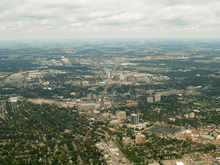
Roads
The Conestoga Parkway, numbered as Highway 85 within Waterloo, connects Waterloo with Kitchener, Highway 7/8 (the continuation of the Conestoga Parkway), Ontario Highway 8, Highway 401 and Cambridge south of Highway 401.
Waterloo shares several of its north–south arterial roads with neighbouring Kitchener. They include (from east to west) Bridge Street, Weber Street, King Street, Westmount Road, Fischer-Hallman Road, and Ira Needles Boulevard. Regina Street (between Weber and King Streets) and Albert Street (between King Street and Westmount Road) are north–south collector roads entirely within Waterloo.
The city's east–west thoroughfares are almost entirely within city limits, with the exception of Union Street, which has a small section in Kitchener, and Bridgeport Road which has its eastern end in the Bridgeport area of Kitchener. Waterloo's major east–west arterial roads are (from south to north) Union Street, Erb Street, Bridgeport Road, University Avenue, Columbia Street, and Northfield Drive.
There are numerous bicycle pathways. The Iron Horse Trail, which originates in Kitchener, enters Uptown Waterloo and links with the Laurel Trail that extends into the northern part of the city.
Public transport

Public transport throughout Waterloo Region is provided by Grand River Transit, created by a merger of Kitchener Transit (which served Waterloo) and Cambridge Transit in January 2000. As of 2020, GRT operates a number of local and express bus routes in Waterloo, with several running into Kitchener. The Kitchener Public Utilities Commission operated electric streetcars serving Kitchener and Waterloo until 1946. Electric trolley coaches replaced the streetcars, operating from on January 1, 1947 to March 26, 1973. In September 2005 an express bus route called iXpress was added for runs from downtown Cambridge to Fairview Park Mall in south Kitchener to Conestoga Mall in north Waterloo. The ION light rail system travels between Conestoga station in Waterloo and Fairway station in Kitchener, with a total of 19 stations along the route. At Fairway station, ION light rail connects to ION bus (Route 302) and travels to the Ainslie Street Terminal in Cambridge. Stage 2 will see the ION bus converted to light rail allowing for a full integration of the Waterloo Region.[39]
Light rapid transit
The Galt, Preston and Hespeler electric railway (later called the Grand River Railway) began to operate in 1894 connecting Preston and Galt. In 1911, the line reached Hespeler, Kitchener (then called Berlin) and Waterloo; by 1916 it had been extended to Brantford/Port Dover.[40][41] The electric rail system ended passenger services in April, 1955, leaving the city and region with no local rail services for more than 60 years.
In June 2011, Waterloo Region council confirmed approval of the plan for a light rail transit line between Conestoga Mall in north Waterloo and Fairview Park Mall in south Kitchener, with rapid buses through to the "downtown Galt" area of Cambridge.[42] Service began June 21, 2019. In the current Stage 1, the Ion rapid transit trains run through the downtown/uptown areas of Kitchener and Waterloo.
Railways
Waterloo is not currently served by any regularly scheduled passenger rail service. Via Rail trains between Sarnia and Toronto stop at the nearby Kitchener railway station southeast of uptown Waterloo at the corner of Victoria Street and Weber Street. The station is accessible by local buses via Kitchener's downtown Charles Street transit terminal. A tourist train that previously ran out of Waterloo Station was moved to depart from St. Jacobs Farmers' Market when construction began on the ION Light Rail line.
The nearest GO Transit railway station is Kitchener GO Station, as the Kitchener Line (formerly the Georgetown Line) has extended to Kitchener on December 19, 2011. In addition, Waterloo is served by GO buses which stop at the University of Waterloo and Wilfrid Laurier University, with destinations of Square One City Centre Terminal, Milton GO Station, and York University.
In May 2007, city council gave approval for a non-profit tourist train to run between Waterloo Station[43] and St. Jacobs, reviving the route of the Waterloo-St. Jacobs Railway from the late 1990s. In 2015, the railway lost regular running rights south of Northfield Drive to make way for the Ion rapid transit project. All Market Train service now departs from the St. Jacobs Farmers Market. The Waterloo Central Railway are run on trains at 10am, 12pm, and 2pm from April to November. The Waterloo Station continues to operate as a Visitor & Heritage Information Centre[43] and is at 10 Father David Bauer Drive.
Intercity transport
In addition to GO bus services mentioned above, Coach Canada offers service from the Charles St. Terminal in Kitchener to McMaster University and Hamilton, Ontario, with various stops, including Sheffield, Rockton and Dundas in between.[44] Greyhound buses to Toronto Bus Terminal also service Waterloo at a stop on the University of Waterloo campus, with some trips operating via Guelph.
Airport
The closest airport to Waterloo is the Region of Waterloo International Airport in nearby Breslau, but while it is a thriving general-aviation field, it is not heavily served by scheduled airlines. Most air travelers use Toronto's Lester B. Pearson International Airport or John C. Munro Hamilton International Airport. WestJet has scheduled daily non-stop service to Calgary from Waterloo International Airport using Boeing 737-700 aircraft in winter season and larger Boeing 737-800 aircraft in spring and summer season. They started service out of Region of Waterloo International Airport on May 14, 2007, for the summer season and then decided to fly year-round due to strong passenger demand. During the winter months Sunwing Airlines offers service to Dominican Republic. Recent upgrades to the runways, approach lighting and terminal building have permitted larger aircraft to use this airport. Airlines that no longer serve the airport include Trillium and Bearskin (to Ottawa), Mesaba (Northwest Airlines' feeder to Detroit), American Airlines (to Chicago) and Sky Service (to sun destinations).
Health care
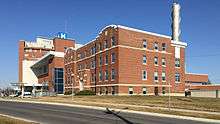
Hospital services in the region are provided by Grand River Hospital which includes a Freeport Campus and St. Mary's General Hospital, both in Kitchener, as well as Cambridge Memorial Hospital.[45] All three were highly ranked for safety in a national comparison study in 2017–2018, particularly the two in Kitchener, but all would benefit from reduced wait times.[46] Long-term care beds are provided at numerous facilities.[47]
Region of Waterloo Paramedic Services and Waterloo Fire Rescue respond to medical emergencies within the city of Waterloo. Region of Waterloo Paramedic Services may transport patients to either Grand River Hospital or St. Mary's General Hospital emergency departments, depending on proximity, anticipated wait times and the type of emergency.
Grand River Hospital has a capacity of 574-beds; the Freeport location was merged into it in April 1995.[48] That secondary campus provides complex continuing care, rehabilitation, longer-term specialized mental health and other services.[49] The King St. location is also the home of the Grand River Regional Cancer Centre which opened in 2003.[50] St. Mary's General Hospital is a 150-bed adult acute-care facility and includes the Regional Cardiac Care Centre with two cardiovascular operating rooms, an eight-bed cardiovascular intensive care unit and 45 inpatient beds.[51][52] As of late 2018, Cambridge Memorial had 143 beds but was in the midst of a major expansion expected to be completed in 2021.[53]
Family doctors are often in short supply, and a source of great concern among residents. Recruiting efforts over the previous 15 years certainly achieved some success as of September 2018, but needed to be continued.[54]
Announced January 2006, as a new School of Medicine, the Waterloo Regional Campus of McMaster University was completed in 2009. In 2018, the Waterloo campus included "a complete on-site clinical skills laboratory with 4 skills rooms and 2 observation rooms, classrooms with video-conferencing capabilities and a state-of-the-art anatomy lab that was built in 2013 with a high definition video system", according to the University. Its Michael G. DeGroote School of Medicine building includes the Centre for Family Medicine and the University of Waterloo School of Optometry and Vision Science.[55]
Libraries
As of 2019, the city maintained three public library branches and late in the year, announced plans to construct a fourth branch, to commence in April 2020. The new University Avenue location was to be attached to RIM Park, a recreational facility. The 1,440 square meter facility was expected to stock about 35,000 books, as well as DVDs and print publications.[56]
Fire Protection
Fire protection and rescue services are provided by Waterloo Fire Rescue, a service of the City of Waterloo. As of 2020, there are four active fire stations in Waterloo. Waterloo Fire Rescue responds to fires, medical emergencies, car accidents and chemical incidents.[57] (Region of Waterloo Paramedic Services also responds to medical emergencies.) When the two tier regional government system was implemented in the early 1970s, police service was moved to the regional government, but fire service remained at the local municipality (city or township) level. From time to time, the media and interested parties raise the question of whether this service should remain at the city level, or whether there might be cost savings or service improvements if the various fire services were merged into a regional fire service. A 2019 newspaper article stated that "there would likely be no cost savings, but service would improve under [a] regionalized system," in the view of some former fire chiefs.[58]
Policing
Waterloo Regional Police Service, the seventh largest police service in the province of Ontario, provides general police service in the city of Waterloo.[59] The Waterloo Regional Police North Division is located at 45 Columbia Street East, Waterloo. Waterloo Regional Police also serve the municipalities of Kitchener and Cambridge and the Townships of Wellesley, Wilmot, Woolwich and North Dumfries. City of Waterloo bylaws controlling matters such as parking, weeds and noise are enforced by city bylaw enforcement officers.[60] The two universities each have special constables who are first responders to all emergencies at their respective university campuses. Special Constables may lay charges and/or make arrests under the same legal authority as police officers.[61] As of 2019, University of Waterloo Police Service had twenty-four Special Constables.[62][63] Wilfrid Laurier University also has a Special Constable Service. The Ontario Provincial Police patrols provincial highways.[64]
Education
The Intelligent Community Forum named Waterloo the Top Intelligent Community of 2007.[65]
Secondary
Until the 1960s, with a few minor exceptions, Waterloo students would attend high school in Berlin/Kitchener. In 1914, Waterloo Lutheran Seminary added a high school department, named the College School, primarily to provide secondary education for prospective seminary students. The College School was discontinued in 1929. Between 1940 and 1950, due to overcrowding in Kitchener–Waterloo Collegiate and Vocational School, some grade nine classes were housed in Elizabeth Ziegler Public School.
Starting in the 1960s, several high schools opened in Waterloo. In 1958 it was announced that Waterloo would have its own secondary school. A $1,247,268 school was built on a 20-acre (81,000 m2) site on Hazel Street. Waterloo Collegiate Institute opened on September 6, 1960. In 1968, Laurel Vocational School (later University Heights Secondary School) opened, and in 1972 Waterloo's third public high school, Bluevale Collegiate Institute, opened. In 1965, St. David Senior School, which served grades 7–10, opened in the north of the city. St. David was turned into a high school in 1985 and was renamed St. David Catholic Secondary School. University Heights Secondary School closed in 2004 and Sir John A. Macdonald Secondary School opened that same year.
As of 2007, there were five high schools based in Waterloo. Three are operated by the Waterloo Region District School Board: Bluevale Collegiate Institute (east), Sir John A. Macdonald Secondary School (west), and Waterloo Collegiate Institute (central). two are operated by the Waterloo Catholic District School Board: St. David Catholic Secondary School and Resurrection Catholic Secondary School.
Post-secondary
The main campuses of the University of Waterloo and Wilfrid Laurier University are in Waterloo. This includes the many associated universities and colleges, including St. Jerome's University, St. Paul's University College, Conrad Grebel University College, Renison University College and the Balsillie School of International Affairs. Kitchener-based Conestoga College also has a Waterloo campus, at the former University Heights Secondary School on University Avenue near Weber Street. Conestoga purchased the building in January 2006 for nearly $6 million from the Waterloo Region District School Board. It is double the size of its previous Waterloo campus on King Street, which was sold after the University Heights building was acquired.
Media
References
- "Population and dwelling counts, for Canada, provinces and territories, and census subdivisions (municipalities), 2016 and 2011 censuses". February 8, 2017. Retrieved February 12, 2017.
- "Kitchener (Census metropolitan area) community profile". 2016 Census data. Statistics Canada. Retrieved February 8, 2011.
- Town of Waterloo [@townwaterloo] (October 30, 2013). "Waterluvians! Don't forget about our trail renaming contest (prize = new bike). Entries accepted until Jan 31" (Tweet) – via Twitter.
- "Haldimand Proclamation, The Canadian Encyclopedia". Retrieved August 27, 2019.
- "History of Waterloo Township". Retrieved August 27, 2019.
- "Our Proud History". City of Waterloo. Retrieved August 30, 2007.
- "Settlement of Waterloo Township". Retrieved August 27, 2019.
- "Waterloo County GenWeb". Retrieved August 27, 2019.
- "Waterloo Township". Waterloo Region Museum Research. Region of Waterloo. 2013. Retrieved March 13, 2017.
To correct the situation, a formal agreement was arranged between Brant and Beasley. This arrangement allowed Beasley to sell the bulk of Block 2 in order to cover his mortgage obligations completely, while giving the Mennonite buyers legal title to land they had purchased. Beasley sold a 60,000 acre tract of land to the German Company of Pennsylvania represented by Daniel Erb and Samuel Bricker in November 1803. Beasley's sale to the German Company not only cleared him of a mortgage debt, but left him with 10,000 acres of Block 2 land which he continued to sell into the 1830s.
- "History" (PDF). Waterloo Historical Society 1930 Annual Meeting. Waterloo Historical Society. 1930. Retrieved March 13, 2017.
- "Erb-Kumpf House, 172 King Street South, Designated: February 19, 1979". City of Waterloo. Retrieved August 30, 2007.
- "History of Waterloo Township". Retrieved August 27, 2019.
- Mills, Rych (March 6, 2017). "Flash from the Past: Tracking Waterloo's mail". Waterloo Region Record.
- Smith, Wm. H. (1846). Smith's Canadian Gazetteer - Statistical and General Information Respecting all parts of The Upper Province, or Canada West. Toronto: H. & W. Rowsell. pp. 205–206.
- Smith, Wm. H. (1846). Smith's Canadian Gazetteer - Statistical and General Information Respecting all parts of The Upper Province, or Canada West. Toronto: H. & W. Rowsell. p. 15.
- Henry McEvoy (March 5, 1869). "The Province of Ontario Gazetteer and Directory: Containing Concise ..." Robertson & Cook – via Internet Archive.
- Jackson, James (September 26, 2018). "University of Waterloo researchers hoping to borrow corduroy road samples". Waterloo Region Record. Retrieved May 28, 2019.
- Jackson, James (May 10, 2018). "Corduroy road gives a glimpse into Waterloo's past". Waterloo Region Record. Retrieved May 28, 2019.
- "Waterloo Wellington A". Canadian Climate Normals 1981–2010. Environment Canada. Retrieved September 15, 2013.
- Outhit, Jeff. "We're growing but not as fast, census shows". Waterloo Region Record. Retrieved February 9, 2017.
- Canada, Government of Canada, Statistics. "2011 National Household Survey Profile - Census subdivision". www12.statcan.gc.ca.
- "Waterloo, City [Census subdivision], Ontario and Waterloo, Regional municipality [Census division], Ontario".
- Government of Canada, Statistics Canada (February 8, 2017). "Census Profile, 2016 Census - Waterloo, City [Census subdivision], Ontario and Ontario [Province]". www12.statcan.gc.ca. Retrieved September 14, 2019.
- "All Data". Statistics Canada. Retrieved August 8, 2007.
- "Canada - Census, Standards & Statistics". doi:10.1163/2213-2996_flg_com_047162. Cite journal requires
|journal=(help) - "Riding profile". Canadian Broadcasting Corporation. Archived from the original on June 12, 2007. Retrieved August 30, 2007.
- "Waterloo". Katapulta. Retrieved June 10, 2019.
- "Town of Waterloo, Ontario: The Hartford of Canada". vitacollections.ca.
- "Waterloo Locations". IMDB. IMDB. 2017. Retrieved March 12, 2017.
- "Profitworks.ca Blog Post – Largest Employers In Waterloo and Kitchener".
A list of the top 20 employers in Waterloo Region. Ranking and figures are for the number of employment positions each company has located in Waterloo Region, not global employment numbers
- "FY 2015 SEC Form 40" (PDF). Research In Motion Investor Relations. Retrieved May 11, 2016.
- "Open Text announces Major Expansion in Waterloo".
Open Text Corporation unveiled plans today to expand its Waterloo facility to two buildings, doubling the company's footprint at its headquarters location
- "Investment prospectus" (PDF).
Wilfrid Laurier University Staff Count
- "It takes a village to raise a Pride". Xtra!, May 29, 2003.
- "Queer Film Festival coming to Waterloo: Rainbow Reels screening 12 films at Princess Twin". Waterloo Region Record, February 24, 2012.
- "Dave Jaworsky elected Waterloo mayor - CBC News".
- "Get to Know Us During Local Government Week". Waterloo Region. Waterloo Region. October 10, 2012. Retrieved March 23, 2013.
- "Waterloo Award". The City of Waterloo. Retrieved November 18, 2017.
- "ION light rail". www.grt.ca. October 23, 2019. Retrieved January 19, 2020.
- "Cambridge and its Influence on Waterloo Region's Light Rail Transit". Waterloo Region. Waterloo Region. January 19, 2017. Retrieved March 10, 2017.
- Mills, Rych (January 10, 2017). "Flash From the Past: Preston Car and Coach goes up in smoke". Record. Kitchener. Retrieved March 10, 2017.
- "Rail plan passes". TheRecord. June 15, 2011. Retrieved February 20, 2012.
- "Visitor and Heritage Information Centre". www.waterloo.ca.
- "Bus Schedules – Charters – Sightseeing – Tours - Coach USA" (PDF). www.coachcanada.com.
- "Hospitals". Region of Waterloo. February 15, 2011. Retrieved December 30, 2018.
- "Waterloo Region hospitals rank well on readmissions, but wait times need work". Waterloo Region Record. November 29, 2018. Retrieved December 30, 2018.
Area hospitals ranked well in patient readmissions, but wait times need improving.
- "Long-Term Care Homes - Kitchener–Waterloo–Wellesley–Wilmot–Woolwich". Health Line. January 3, 2018. Retrieved December 30, 2018.
- "About GRH". GRH. November 15, 2017. Retrieved December 30, 2018.
- "Freeport Campus: 3570 King Street East, Kitchener". GRH. November 15, 2017. Retrieved December 30, 2018.
- "Grand River Regional Cancer Centre celebrates 15 years of advanced cancer care this fall". GRH. August 30, 2018. Retrieved December 30, 2018.
- "Regional Cardiac Care Centre". SMGH. September 15, 2018. Retrieved December 30, 2018.
- "About Us". SMGH. September 15, 2018. Retrieved December 30, 2018.
- "Banks take control of Cambridge hospital project". Waterloo Region Record. December 29, 2018. Retrieved December 30, 2018.
BMO, as a lender and funder, called a performance bond to ensure there is funding to get the work done. Zurich Insurance is Bondfield's insurer.
- "Doctor recruitment an ongoing issue in Waterloo Region". Waterloo Region Record. September 18, 2018. Retrieved December 30, 2018.
BAlthough recruitment efforts over the past 15 years or so have brought many new physicians to the area, many residents are without a family doctor.
- "Waterloo Regional Campus". McMaster. March 15, 2018. Retrieved December 30, 2018.
- "Long wait for new Waterloo library nears its end". Waterloo Region Record. December 16, 2019. Retrieved December 19, 2019.
- "Fire and emergency services". City of Waterloo. Retrieved March 7, 2020.
- Jackson, Adam; Jackson, Bill (March 18, 2019). "Region of Waterloo Fire Department? It's a possibility". Waterloo Chronicle. Retrieved March 7, 2020.
- "About Us". Waterloo Regional Police. Retrieved March 7, 2020.
- "Bylaws and enforcement". www.waterloo.ca. City of Waterloo. March 4, 2020. Retrieved March 7, 2020.
- "Special Constable Service | Students - Wilfrid Laurier University". students.wlu.ca. Wilfrid Laurier University. Retrieved March 7, 2020.
- "University of Waterloo Police Service 2019 Annual Report" (PDF). University of Waterloo. Retrieved March 7, 2020.
- Rushowy, Kristin (August 2, 2019). "No 'cops' on campus: New law says special constables can't be called 'police'". TheRecord.com. Retrieved March 7, 2020.
- "Ontario Provincial Police - What we do". Ontario Provincial Police. Retrieved March 7, 2020.
- "Intelligent Community Awards 2007". Intelligent Community Forum. Archived from the original on June 13, 2007. Retrieved August 8, 2007.
External links
| Wikimedia Commons has media related to Waterloo, Ontario. |

- City of Waterloo
- Waterloo Visitor and Heritage Information Centre
